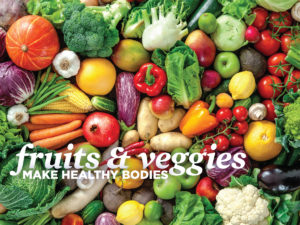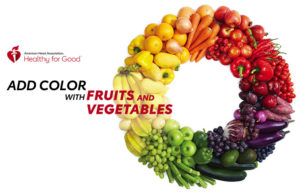Fruits and vegetables are part of a well-balanced and healthy eating plan. There are many different ways to lose or maintain a healthy weight. Using more fruits and vegetables along with whole grains and lean meats, nuts, and beans is a safe and healthy one. Helping control your weight is not the only benefit of eating more fruits and vegetables. Diets rich in fruits and vegetables may reduce the risk of some types of cancer and other chronic diseases. Fruits and vegetables also provide essential vitamins and minerals, fiber, and other substances that are important for good health.
This doesn’t necessarily mean that you have to eat less food. You can create lower-calorie versions of some of your favorite dishes by substituting low-calorie fruits and vegetables in place of higher-calorie ingredients. The water and fiber in fruits and vegetables will add volume to your dishes, so you can eat the same amount of food with fewer calories. Most fruits and vegetables are naturally low in fat and calories and are filling.
Instead of a high-calorie snack from a vending machine, bring some cut-up vegetables or fruit from home. A 1-ounce bag of corn chips has as many calories as a small apple, 1 cup of whole strawberries, AND 1 cup of carrots with 1/4 cup of low-calorie dip. Substitute one or two of these options for the chips, and you will have a satisfying snack with fewer calories.
Remember: Substitution is the key.
It’s true that fruits and vegetables are lower in calories than many other foods, but they do contain some calories. If you start eating fruits and vegetables in addition to what you usually eat, you are adding calories and may gain weight. The key is substitution. Eat fruits and vegetables instead of some other higher-calorie food.
Eat fruits and vegetables the way nature provided—or with fat-free or low-fat cooking techniques.
Try steaming your vegetables, using low-calorie or low-fat dressings, and using herbs and spices to add flavor. Some cooking techniques, such as breading and frying, or using high-fat dressings or sauces will greatly increase the calories and fat in the dish. And eat your fruit raw to enjoy its natural sweetness.
Canned or frozen fruits and vegetables are also good options.
Frozen or canned fruits and vegetables can be just as nutritious as the fresh varieties. However, be careful to choose those without added sugar, syrup, cream sauces, or other ingredients that will add calories.
Choose whole fruit over fruit drinks and juices. Fruit juices have lost fiber from the fruit.
It is better to eat the whole fruit because it contains the added fiber that helps you feel full. One 6-ounce serving of orange juice has 85 calories, compared to just 65 calories in a medium orange.
Whole fruit gives you a bigger size snack than the same fruit dried—for the same number of calories.
A small box of raisins (1/4 cup) is about 100 calories. For the same number of calories, you can eat 1 cup of grapes.

